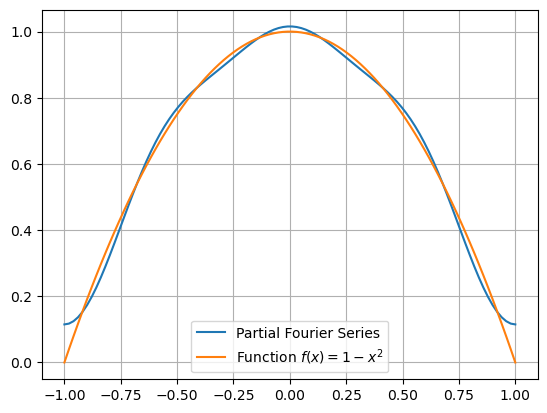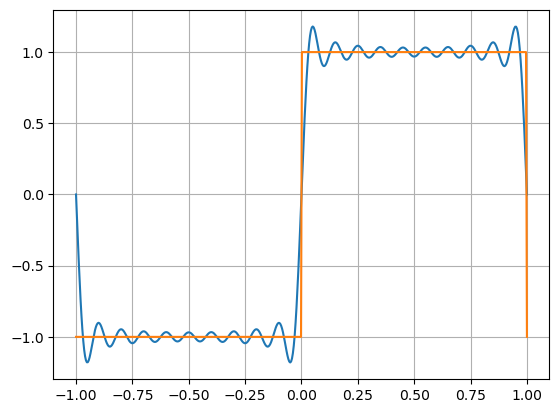Fourier Series#
import numpy as np
import matplotlib.pyplot as plt
import scipy.integrate as spi
Definition#
Let \(f(x)\) be a (piecewise) continuous function on the interval \([-L,L]\). The Fourier series of \(f(x)\) is
where the coefficients are given by the integrals
Computing Coefficients#
Use the SciPy funciton scipy.integrate.quad (see documentation) to numerically approximate a definite integral. For example, let’s approximate the integral
f = lambda x: np.sin(x**2)
a = 0
b = 1
I,error = spi.quad(f,a,b)
The function returns the approximation and an upper bound for the error:
I
0.3102683017233811
error
3.444670123846428e-15
Let’s use the function scipy.integrate.quad to approximate first few Fourier coefficients of the function \(f(x) = 1 - x^2\) on the interval \([-1,1]\).
f = lambda x: 1 - x**2
L = 1
I0,_ = spi.quad(f,-L,L)
a0 = 1/L*I0
a0
1.3333333333333335
integrand_a1 = lambda x: f(x)*np.cos(np.pi*x/L)
Ia1,_ = spi.quad(integrand_a1,-L,L)
a1 = 1/L*Ia1
a1
0.40528473456935127
integrand_a2 = lambda x: f(x)*np.cos(2*np.pi*x/L)
Ia2,_ = spi.quad(integrand_a2,-L,L)
a2 = 1/L*Ia2
a2
-0.10132118364233778
integrand_b1 = lambda x: f(x)*np.sin(np.pi*x/L)
Ib1,_ = spi.quad(integrand_b1,-L,L)
b1 = 1/L*Ib1
b1
0.0
integrand_b2 = lambda x: f(x)*np.sin(2*np.pi*x/L)
Ib2,_ = spi.quad(integrand_b2,-L,L)
b2 = 1/L*Ib2
b2
0.0
Of course, all the coefficients \(b_n = 0\) since \(f(x)\) is an even function.
The function fourier takes input parameters f, L and N, and returns a tuple (a0,a,b) where:
fis a Python function representing \(f(x)\)Ldefines the interval \([-L,L]\)Nis the number of coefficients to computea0is the constant term \(a_0\) in the Fourier seriesais a NumPy array of length \(N\) of Fourier coefficients \(a_1,\dots,a_N\)bis a NumPy array of length \(N\) of Fourier coefficients \(b_1,\dots,b_N\)
def fourier(f,L,N):
a = np.zeros(N)
b = np.zeros(N)
I,_ = spi.quad(f,-L,L)
a0 = 1/L*I
for n in range(1,N+1):
integrand = lambda x: f(x)*np.cos(n*np.pi*x/L)
I,_ = spi.quad(integrand,-L,L)
a[n-1] = 1/L*I
integrand = lambda x: f(x)*np.sin(n*np.pi*x/L)
I,_ = spi.quad(integrand,-L,L)
b[n-1] = 1/L*I
return a0,a,b
For example, let’s apply fourier to \(f(x) = 1 - x^2\) on \([-1,1]\) and recover the coefficients computed in the example in the previous section above.
f = lambda x: 1 - x**2
L = 1
N = 5
a0,a,b = fourier(f,L,N)
a0
1.3333333333333335
a
array([ 0.40528473, -0.10132118, 0.04503164, -0.0253303 , 0.01621139])
b
array([0., 0., 0., 0., 0.])
Now let’s try an example where \(f(x)\) is a sum of sine and cosine functions to verify that the function fourier simply recovers the coefficients in the definition of \(f(x)\).
f = lambda x: 1 + 3*np.sin(np.pi*x) + np.cos(np.pi*x) + 3*np.sin(3*np.pi*x)
L = 1
N = 4
a0,a,b = fourier(f,L,N)
a0
2.0000000000000004
a
array([ 1.00000000e+00, -8.32667268e-17, -2.77555756e-17, -5.55111512e-17])
b
array([ 3.00000000e+00, 0.00000000e+00, 3.00000000e+00, -3.33066907e-16])
When programming in Python, we can interpret numbers such as \(10^{-16}\) as 0 therefore we have \(a_0 = 2\), \(a_1 = 1\), \(a_2 = a_3 = a_4 = 0\), \(b_1 = 3\), \(b_2 = b_4 = 0\) and \(b_3 = 3\).
Computing Series#
The function fouriersum takes the output a0, a and b from the function fourier along with array x and number L and returns the array of \(y\) values given by the sum
def fouriersum(a0,a,b,x,L):
cosine_sum = sum([a[n-1]*np.cos(n*np.pi*x/L) for n in range(1,len(a)+1)])
sine_sum = sum([b[n-1]*np.sin(n*np.pi*x/L) for n in range(1,len(b)+1)])
return a0/2 + cosine_sum + sine_sum
Let’s plot the function \(f(x) = 1 - x^2\) along with the partial Fourier series up to \(N=3\).
f = lambda x: 1 - x**2
L = 1
N = 3
a0,a,b = fourier(f,L,N)
x = np.linspace(-L,L,100)
y = fouriersum(a0,a,b,x,L)
plt.plot(x,y,label="Partial Fourier Series")
plt.plot(x,f(x),label="Function $f(x) = 1-x^2$")
plt.grid(True), plt.legend()
plt.show()

Examples#
Sawtooth Wave#
import scipy.signal as sps
f = lambda x: sps.sawtooth(2*np.pi*x,width=0.5)
L = 2
a0,a,b = fourier(f,L,15)
x = np.linspace(-L,L,500)
y = fouriersum(a0,a,b,x,L)
plt.plot(x,y)
plt.plot(x,f(x))
plt.grid(True)
plt.show()

Square Wave#
f = lambda x: sps.square(np.pi*x)
L = 1
N = 20
a0,a,b = fourier(f,L,N)
x = np.linspace(-L,L,500)
y = fouriersum(a0,a,b,x,L)
plt.plot(x,y)
plt.plot(x,f(x))
plt.grid(True)
plt.show()

